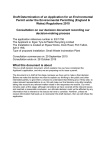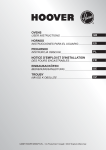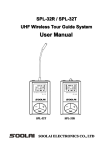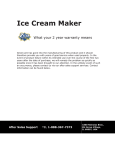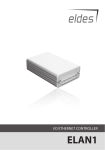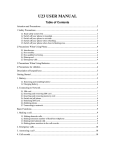Download Candy F 279 P Technical data
Transcript
FR
GB
ES
NOTICE D'EMPLOI ET D'INSTALLATION DES FOURS ENCASTRABLES
INSTRUCTIONS FOR THE USE AND INSTALLATION OF BUILT-IN OVENS
INSTRUCCIONES DE FUNCIONAMIENTO E INSTALACIÓN HORNO
EMPOTRABLE
BE
NL
GEBRUIKS- EN INSTALLATIEHANDELEIDING VOOR INBOUWOVENS
GEBRUIKSAANWIJZING EN INSTALLATIE VAN INBOUWOVENS
~~~
F 248 P
93783991
F 279 P
1
CONTENTS
SAFETY ADVICE --------------------------------------------------------------------- 25
RECOMMENDATIONS ------------------------------------------------------------ 25
• INSTALLATION
OVEN INSTALLATION
. Fitted
------------------------------------------------- 26 to 27
. Electrical connection
------------------------------------------------ 28 to 29
TECHNICAL DATA
--------------------------------------------------------- 30
• USING THE APPLIANCE
PRESENTATION OF THE CONTROL PANEL ---------------------------- 31
THE ELECTRONIC TIMER ----------------------------------------------- 32 to 33
24
COOKING METHODS
--------------------------------------------------------- 34
USING THE OVEN
--------------------------------------------------------- 35
COOKING TIPS
------------------------------------------------ 36 to 38
ROTISSERIE
--------------------------------------------------------- 39
OVEN ACCESSORIES
--------------------------------------------------------- 40
CLEANING
. General maintenance
. The Pyrolyser
------------------------------------------------ 41 to 42
------------------------------------------------ 43 to 44
SAFETY DEVICE
• Please read your instructions given in this booklet ; they provide important information
on the safety of the installation, use and servicing, as well as some advice on how to get the
best from your oven. Keep this document carefully for later consultation.
If these instructions are not fo
llowed correctly we cannot be held responsible for
followed
any problems which may arise.
• Your oven should be installed and connected electrically by an approved installer or
similar qualified technician.
• The oven that you have just acquired has defined technical characteristics and in no case
should you make any modifications to the equipment.
• The oven door and all other accessible parts become hot during operation. You are
advised to keep children away from the oven during use.
• Before operating the pyrolyser cycle, it is much important to remove any of the larger
quantities of grease. Too many large greasy deposits could catch fire under the effect of the
high heat pyrolyser cycle.
• Never use a steam or high pressure device to clean the oven.
• If the oven shows any defect whatever, disconnect it from the power supply and immediately
contact an approved CANDY service agent.
• Do not store inflammable products in the oven ; they can be set alight if the oven
accidentally comes on.
• Do not put your weight on or let children sit on the oven door.
• Use kitchen gloves when putting dishes into or taking dishes out of the oven.
RECOMMENDATIONS
• After each use, it is recommended that the oven should be given a quick clean.
• Do not line the walls of the oven with aluminium foil as direct contact can melt the foil
and damage the oven enamel.
• To avoid any unnecessary oven soiling or the production of excessive smoke we recommend
that the oven not be used at too high a temperature. It is far better to extend the cooking
time while lowering the oven temperature.
• In addition to the accessories supplied with the oven, we recommend that you only use
dishes, which are specifically made for oven use.
25
INSTALLATION : "FITTED"
THESE INSTRUCTIONS ARE OF PARTICULAR INTEREST TO INSTALLERS.
The furniture in which you install your oven should be made of materials which can withstand
high temperatures.
The oven can be fitted under a worktop, set into a masonry niche or simply placed at the top of
a column (page 27).
Before it is fitted :
You must ensure good ventilation in the oven space to allow proper circulation of the fresh
air required for cooling and protecting the internal parts. Provide openings divided as shown
in the following figures.
Fitting the oven in its space :
Inside the oven is a bag with fixing screws.
Fixing :
Four holes are located on the side flanges.
Use the screws fitted to fix the oven.
26
INSTALLATION : "FITTED"
1 - Oven placed at
the top of a column
(dimensions in mm)
553
560
23
580
54
9
598
577
0
55 i
min
596
20
500
HOB
TABLE
10 mini
2 - Oven fitted
under a worktop
50
602 mini
(dimensions in mm)
OVEN
FOUR
Opening
Ouverture
500 X 50
Opening
Ouverture
500 x 10
27
INSTALLATION : "ELECTRICAL CONNECTION"
THESE INSTRUCTIONS ARE OF PARTICULAR INTEREST TO INSTALLERS.
The mains electricity supply connected to the appliance should comply with the norms in
force in the country of installation.
Candy declines all responsibility if the above compliance is not observed.
Connection to the mains electricity should be through a plug with an earth terminal, or
through an intermediary switching device with a gap between contacts of at least 3 mm.
The power supply unit must be protected by appropriate fuses and use cables of a large
enough cross section to provide a normal supply to the appliance.
CONNECTION :
The oven is fitted with a power supply cable for connecting exclusively to a voltage of
220/240 V~ across the phases or across phase and neutral.
Connection must be carried out in compliance with the diagram on the next page, having
first checked:
. the supply voltage indicated on the meter,
. the circuit breaker system.
The earth wire (green/yellow) must be connected to the earth both of the oven and of the
power supply system.
Caution :
. Check the continuity of the earth installation before connecting.
. The manufacturer will not be liable for any accident or the possible
consequences that may arise from the use of the oven which has not been
earthed correctly or connected to an earth with defective continuity.
NOTA : do not forget that the oven may require after sales services. Position the plug outlet
so that the oven can be removed from its space while still connected to allow easy servicing.
Power supply cable : if the power supply cable has to be changed, please have this done by
our after sales technicians or by qualified engineer.
28
INSTALLATION : "ELECTRICAL CONNECTION"
INSTALLATION WITH PLUG
INSTALLATION AVEC PRISE
220/240 V ~ Electrical meter
across the phases or across phase and neutral
16 Amp Fuse
FUSIBLE
16 Ampères
PRISE DE COURANT
16 Ampères
16
Amp Plug
Phases
+ Terre"
"2"2
Phases
+ Earth"
ou
or
"1 Phase + Neutre
"1 phase ++Terre"
Neutral +
Earth"
Four équipé
de son câble
(type H05VV-F
section 3G1,5)
29
TECHNICAL DATA
This data is provided for information only. In order to improve the quality of your products,
CANDY may modify the equipment with technological developments which conform to
the regulations in force.
The apparatus complies with Directive 89/336/CEE, 73/23/CEE and
89/109/CEE.
------------------------------------------------------------------------------------------------------------F 279 P
F 248 P
-------------------------------------------------------------------------------------------------------------
Oven dimens
ions (in cm)
dimensions
Width x Height x Depth
Oven internal dimen
sions (in cm)
dimensions
Width x Height x Depth
Volume in litres
Power in Watt
Lighting
Defrost
Natural convection
Fan oven
Lower element
Lower element & Fan
Grill
Rotisserie
Turbo-grill
Pyrolyser
59,5 X 60 X 56
43 x 30 x 39
50
15
2510
1480
2150
2150
2500
Consumption during natural convection (kWh)
* rise to 200°C
0,45
* holding for 1 hour at 200°C
0,55
* Pyrolyser cycle (for 80 minutes)
3,20
Electrical connection
Fuse
43 x 30 x 37,5
48
15
40
2510
2540
1500
2150
2150
2170
2500
0,45
0,60
3,30
Single phase 220/240 V~ + Earth
16 A
------------------------------------------------------------------------------------------------------------30
PRESENTATION OF THE CONTROL PANEL
F 279 P
F248 P
1 • Electronic timer :
takes in charge all the oven functions.
2 • Heat indicator light :
shows that the thermostat function has been operated.
3 • Thermostat oven control knob :
from 60°C to 280°C.
4 • Selector oven function control knob :
F 279 P :
Oven lighting - 4 cooking functions (natural convection, lower element, grill, and
rotisserie) - 1 cleaning function by pyrolyser.
F 248 P :
Oven lighting - 7 cooking functions (defrost, natural convection, fan oven, lower
element + fan, grill, turbo-grill, and rotisserie) - 1 cleaning function by pyrolyser.
5 • Pyrolyser indicator light :
indicates that pyrolyser cycle is operating and the oven door is locked.
31
THE ELECTRONIC TIMER
• PRESENTATION
Cooking symbol :
. when this is lit up, the oven
is in the cooking position
. when it goes out, cooking
has finished.
1: independent timer/alarm
2: time
3: end of time
4: manual position
5 & 6: regulation of all functions
("-" and "+")
Auto symbol :
. when this is not lit up, the
programmer is in the manual position.
. When it is lit up, it indicates
that a programme has been set and
is running.
. When it is flashing, the selected
programme has finished and the
programmer will still be on the
automatic setting. Return it to the
manual position or select a new
programme.
• CLOCK
The time of day should be set when the oven is connected to the power supply. Before the oven is
connected to the power supply, or after a power cut, the symbol Auto flashes.
. Press buttons "1" and "2" at the same time, and then release them,
. Press the regulator buttons "5" or "6" to set the desired time.
• TIMER
The timer can be used on its own, as a reminder. A bleep will sound when the set time is
up.
. Press button "1" and then the regulator buttons "5" or "6" to set the desired time.
The symbol
will appear. When the buttons are released, the time of day will be displayed.
When the set time is up, an alarm will sound. To stop it, press button 1, 2, 3 or 4.
Before starting a cooking or pyrolyser cycle in the oven, you have to set on
the timer, either the manual position (cooking mode) or a cycle time with or
without start delay.
• MANUAL USE
Cooking starts immediately. When you required, the oven can be switched off simply by turning the
knobs back to the off position.
. Check that Auto symbol is not displayed : if necessary, press button "4" to make the
"Auto" symbol disappear.
. Select a temperature by turning the thermostat control knob.
. Position the selector control knob on required cooking mode.
The indicator lights come on. Cooking will then start immediately.
To stop the oven working, turn the selector and thermostat knobs back to off position.
32
THE ELECTRONIC TIMER
• PROGRAMMATION WITH TIME
Programming for a cooking time, or a pyrolyser cycle, with immediate start and automatic
switching off the oven.
Set a time on the timer :
. Press button "2" and release it.
. Using regulator buttons "5" or "6", set a time.
The symbols Auto and
will light up.
Set a temperature using the thermostat control knob for cooking operation.
Position the selector control knob on the required function.
The indicator lights will come on and the oven will start to heat up.
It will automatically switch itself off when the time is up.
The end of time will be signalled by an alarm. Stop the alarm by pressing button 1, 2, 3 or 4.
The symbol Auto will flash ; to stop it press button "4" to display manual position on the timer.
• PROGRAMMING WITH TIME AND START DELAY
The timer takes control of all functioning done in the oven or of the pyrolyser cycle, with
automatic start and finish.
Set a time :
. Press button "2" and release it.
. Using regulator buttons "5" or "6", set a time.
The symbols Auto and
will light up.
Set an end of time :
. Press button "3" and release it.
. Using regulator buttons "5" or "6", select an end of time.
The symbol
will disappear and will only reappear when the oven starts.
Set a temperature using the thermostat control knob for cooking operation.
Position the selector control knob on the required oven function.
The programmer calculates the starting time, according to the end and the length of time.
Oven functioning will start automatically and will stop when the time is up. During oven functioning
the indicator lights will be on.
The end of time will be signalled by an alarm. Stop the alarm by pressing button 1, 2, 3 or 4.
The symbol Auto will flash, to stop press button "4" to display manual position on the timer.
33
THE OVEN METHODS
They are different according to the oven type.
Oven lighting : the oven lights automatically as soon as the oven is operating (except
in pyrolyser cycle).
Natural convection : both top and bottom heating elements are in use.
This function is ideal for all traditional cooking, for cooking red meats, roast beef, leg
of lamb, game, bread, puff pastry. 10 minutes preheating is recommended.
Defrost : Air at ambient temperature is circulated around the item being defrosted.
This quickens defrosting considerably, without any cooking taking place.
Lower element only : only the lower element operates. This function is ideal for
cooking all pastry based dishes. Suitable for tarts, quiches, cakes, pastries and all dishes
require more heat and radiation from below.
Grill : the upper element only is operating. This guarantees excellent results for fillets
of meat or fish, skewered meat and gratins. 5 minutes preheating is required for the
element to become red. Red meat and fish fillets can be placed directly onto the shelf
with the drip tray placed beneath on lower shelf position.
White meats should always be placed at some distance from the grill element, the
cooking time is slightly longer but the meat will be more succulent.
The oven door should be kept ajar.
Fan oven : simultaneous operation of the upper and lower element and also the fan
which circulates air round the inside of the oven. This function is ideal for poultry,
confectionery, fish, vegetables. The heat better penetrates inside the food and reduces
cooking time. You can do combined cooking with the same or different dishes, on one
or two levels.
Lower element & fan : the lower element operates together with the fan which
circulates air round the inside of the oven. This function is ideal for juicy fruit tarts,
cakes, quiches and pastry. It prevents food from becoming too dry and helps cakes,
pastry, bread, etc to rise. Cooking from below. Place the oven shelf on the lowest level.
Turbo-grill : the upper element operates together with the fan which circulates air
round the inside of the oven. When the turbo-grill is in use the door should be closed.
Ideal for cooking thick pieces of pork, poultry and the like. Preheating is necessary for
red meats but not for white meats. Place the food directly on the shelf in the centre of
the oven. Slide the drip tray under the shelf in order to collect the fat. Make sure the
food is not too close to the grill. Turn the food half way through cooking.
Rotisserie : the upper element and the rotisserie operate together. The food rotates
during cooking. Ideal for rediscovering all the flavours of traditional spit roasting.
Preheating is not necessary when cooking with the rotisserie. When the rotisserie is
in use the door should be left ajar.
P
34
Pyrolyser : full cleaning of the oven by burning of all the stains. Remove all accessories
from the oven.
USING THE OVEN
. Always keep small children away from the oven while it is in use.
. Do not line the walls of the oven with aluminium foil. Aluminium foil in direct
contact with the hot enamel risks melting and deteriorating the enamel.
1.
Choose cooking mode :
. Turn the function selector knob to the cooking position you want.
Each cooking mode has an appropriate temperature. For that, see the following
indications mentioned below.
2.
Set a temperature :
. Turn the thermostat knob to the required temperature for your cooking.
Defrost : thermostat control knob on "off",
Natural convection : between 60°C and 280°C,
Fan oven : between 60°C and 240°C,
Lower element & fan : between 60°C and 240°C,
Lower element : between 60°C and 280°C,
Grill : temperature maxi. 280°C,
Turbo-grill : between 180°C and 230°C,
Rotisserie : temperature maxi. 280°C.
3.
Set the electronic timer :
. Select either the manual position or a cooking time with or without start delay.
The heat indicator light indicates that the thermostat is operating. It goes on and off
throughout cooking time.
Note : the cooling fan starts automatically when the cooking cycle starts, and stops
automatically when the temperature of the oven is less than 150°C, this is why it continues
to rotate for some minutes after the oven is swtiched off.
35
COOKING TIPS
It is advisable not to salt meat before cooking, as salt only encourages the production of fat
which quickly spreads throughout the oven causes unnecessary smoke.
Joints of white meat, pork, veal, lamb and fish should be put into the oven cold. The
cooking time is longer than in a preheated oven, but it cooks more thoroughly at the centre
as the heat has more time to penetrate the joint.
CORRECT PREHEATING IS THE BASIS OF SUCCESSFUL
RED MEAT COOKERY.
GRILLING :
Before inserting grilling :
Remove the meat from the refrigerator a few hours before grilling.
We advise laying it on several layers of absorbent paper : this will remove excess water
concentrating the flavour, makes it tastier and preventing it staying cold at the centre.
Add pepper and spices to the food to be cooked with a little oil. This is best done with a
wide flat basting brush. Then sprinkle with more pepper and herbs (thyme, etc.).
During cooking :
Never pierce the food during cooking even when you turn it. This lets the juice out and it
becomes dry.
Caution :
Never use the drip tray as a roasting dish.
BAKING :
Avoid using shiny tins, they reflect the heat and can spoil your cakes. If your cakes brown
too quickly, cover them with greaseproof paper or aluminium foil.
Caution : the correct way to use foil is with the shiny side in towards the cake (dull side
out). If not the heat is reflected from the shiny surface and will not penetrate the food.
Avoid opening the door during the first 20 to 25 minutes of cooking : sponge cakes,
soufflés and brioche will tend to fall.
You can check if cakes are done by pricking the centre with a knife blade or metal knitting
needle. If it comes out nice and dry, your cake is ready, and you can stop the cooking. If
the blade come out moist or with bits of cake stuck to it, continue baking but lower the
temperature slightly so that it finishes cooking without burning.
Refer to the tables on following pages to make the first use of the appliance easier.
You can then improve it if necessary, while knowing that higher the temperature of a
cooking is, larger are the splashes which so increase the fouling of the casing and the coming
out of fumes.
It is better most of the times, to reduce lightly the temperature of cooking, even if you
must somewhat increase the cooking time.
36
COOKING TIPS - NATURAL CONVECTION
Foods
Temperature
of cooking
Quantity
Cooking
time
Oven position
20'
1
Whole fish, roasted or braised
Fish
1 kg
200 / 220
Meat vegetables
Beef with carrots
6 pers.
200 / 220
4 approx.
1
Duck
1,5 kg
200 / 220
1 h 30
1
Braised cabbage
6 pers.
200 / 220
1 h approx.
1
Leeks
6 pers.
200 / 220
1 h approx.
1
200 / 220
15' p/pound
1
160 / 180
2 h 30 - 3 h
1
200 / 220
1 hour for 1 kilo
1
Leg of lamb
Goose turkey
7 kg
Pies
Roast chicken
1 / 1kg 200
200 / 220
45' - 1 hour
1
Savoury tart
Ø27 - 6 pers.
200 / 220
40 / 50'
1
230 / 240
15 min p/pound
1
Roast beef
Desserts
Cake
1 kg 500
180 / 200
50 / 60'
1
Fruit cake
Ø27- 6 pers.
200 / 220
40 / 45'
1
Crème caramel
individual
ramekin
80 / 90
45'
in double boiler
1
200
40'
3
Chou pastry
Crumbly biscuit
1 kg 500
200 / 220
45' / 1 hour
1
Garnished cake
Ø27- 6 pers.
200 / 220
40 / 45'
1
37
COOKING TIPS - FAN OVEN
Foods
Temperature
of cooking
Quantity
Cooking
time
Oven position
Fish fillets
Salmon steak
6 pieces
140 / 160
8 / 10'
1
Sole fillet
6 pieces
140 / 160
5' approx.
1
Meat - Vegetables
Stuffed cabbage
6 pers.
200 / 220
1 h 30 to 2 h
1
Endives with cheese and
ham
6 pers.
180 / 200
25 / 30'
1
"Gratin" food
6 pers.
200 / 220
15 / 20'
1
Roast rabbit
800 gr / 1 kg
200 / 220
50 / 60'
1
Jacket potatoes
6 pieces
200 / 220
1 hour approx.
1
200 / 220
40/50' for 1 Kg
1
Roast pork
Salted - sweet soufflé
Ø22 - 6 pers.
180 / 200
1 hour approx.
1
Stuffed tomatoes
6 à 8 pieces
200 / 220
45'
1
Desserts
38
Brioche
800 gr
200
40 / 45'
1
Baked custard
ramekins
180 / 200
30'
1
Sponge biscuit
Ø 27
180 / 200
35 / 40'
1
Meringues
according to
size
60 / 80
60 / 90'
1
Lemon soufflé
Ø22- 6 pers.
200
1 hour
1
Sweet tart base
Ø 27 / 28
180 / 200
20 / 30'
1
Puff pastry
6 pieces
200
15 / 20'
1
ROTISSERIE
USING THE ROTISSERIE :
- Remove all accessories from the oven.
- Skewer the food to be cooked and centre it between
the two forks,
- place the skewer on the holder,
- slide the holder and skewer into the second shelf position
from the bottom and secure. (see view below).
The end of the skewer will then be facing the slot in the drive mechanism,
- fit the skewer into the drive mechanism.
- Place the drip tray on the oven bottom.
- Turn the selector control knob to the Rotisserie function
.
- and the thermostat control knob on 280°C.
No preheating is required for rotisserie cooking.
The rotisserie is best used for medium sized items. Cook larger pieces in the oven using
another mode, which will provide better results.
COOKING TIMES :
. Beef (1 kg) : 20/30 minutes,
. Veal, poultry (1 kg) : 60/70 minutes,
. Lamb, mutton (1kg) : 30/40 minutes,
. Pork (1 kg) : 55/65 minutes.
ROTISSERIE COOKING MODE : COOK WITH THE DOOR AJAR
Cross rotisserie
Axial rotisserie
Boss setting at the back
Fit the skewer in the drive mechanism.
39
OVEN ACCESSORIES
- According to model 2
1
3
Oven shelves
1 : It is for holding dishes and plates.
2 : It is for holding meat joints when cooking with the grill or turbo-grill. It is fitted with
rails into which can be slid the drip tray.
The drip tray
3 : The drip tray must be used only in grill, turbo-grill or rotisserie mode.
With the other modes, the drip tray has to be removed.
It is designed to collect the juices that drip from food as it is grilled. It can be placed on the
shelf, slid into the rails, or placed on the oven bottom.
Never use the drip tray as a roasting dish. This would cause smoke to be produced, fat to
be splashed and the oven would become rapidly stained.
Avoid using glass dishes to cook meat.
Use deep dishes rather made of earthenware.
40
CLEANING : "GENERAL MAINTENANCE"
. Wait for the oven to cool down before doing any cleaning by hand.
. Never clean with abrasive cleaners, wire wool or sharp objects, or the enamel
may be damaged beyond repair.
. Use only soapy water or bleach (ammonia) cleaners.
. Never line the oven wall with aluminium foil.
The oven door glass : it is recommended to wipe the oven door glass with absorbent paper
after each cooking cycle. If there is heavy staining, the glass can be cleaned with a sponge
and cleaning agent.
Photo 1 :
original position
The oven door : it is possible to clean the
oven door while in position or after removal.
To remove the door simply :
. open the door fully,
hook downwards
. the hinges appear as shown in photo 1,
. lift the hooks free of the hinges (photo 2)
. pull the door upwards, partially closing it
again until it can be lifted off.
When refitting, make sure that you re-position the hinges
correctly ; a notch located on the hinges (photo 3) enables
you to fit them correctly.
Re-fit the door by positioning the hooks on the hinges in
their original position as shown in photo 1.
Photo 2 :
lifting the hook
Photo 3 :
notch on hinge
The oven door seal : if necessary, clean the seal with a sponge dipped in soapy water. Rinse
with clean water and dry off.
The shelf : clean the shelf with a sponge dipped in soapy water. Rinse with clean water and
dry off. Avoid abrasive cleaners.
The drip tray : after grilling, remove the drip tray from the oven into a container. Wash
and rinse the drip tray in very hot water, using a sponge and washing powder.
If still stained with sticky food, immerse in soapy water. The drip tray can be cleaned in the
dishwasher.
Never put the drip tray back in the oven if still dirty.
Never pyrolyse the drip tray.
41
CLEANING : "GENERAL MAINTENANCE"
OVEN LIGHTING : disconnect the power supply before cleaning or replacing the
bulb.
The bulb and its cover are made of high temperature resistant materials.
Bulb technical data :
220/240 V~ - 15 W - Base E 14 Temperature 300°C
To change a defective bulb :
. just unscrew the glass cover,
. unscrew the bulb,
. replace it with one of the same type : see above
technical data,
. after changing, screw back the protective cover.
42
CLEANING : "THE PYROLYSER"
The pyrolyser is a system for the high temperature destruction of stains. The work is done
automatically by means of the timer. The resulting fumes are rendered "clean" by passing
through a pyrolyser whose action begins while the food is cooking. Because the pyrolyse
requires such high temperatures, the oven door is fitted with a safety lock. As long as the
temperature inside the oven is above 320°C, the door cannot be opened.
IMPORTANT
IMPORTAN
T:
. If a hob has been fitted above the oven, never use the gas burners or electric hot plates while
the pyrolyser is operating, this will prevent the hob from overheating.
. Remove heavy spillages or residues as it would take too long to destroy them. Also, any
heavy stain or grease residue is at risk of catching fire in the intense heat of the pyrolyser.
. Never use commercially available products for cleaning a pyrolyser oven.
During pyrolyser cycle, the oven door becomes hot. Keep children away from it.
Before carrying out the pyrolyser cycle
- Remove all accessories from the oven : they cannot withstand the pyrolyser
temperatures without being damaged.
- Remove heavy spillages or residues as it would take too long to destroy them.
- Close the oven door.
- Leave the thermostat control knob in the off position.
- Turn the selector control knob to the left, to the "P" mark.
- The electronic programmer fixes a pre-set pyrolyser time (1 h 30 min.) which
corresponds to the minimum time required to complete a pyrolyser cycle and usually
allows perfect cleaning. The pre-set time can be changed :
1 h 30 minutes
:
for normal staining
heavy staining
1 h 45 minutes
:
very heavy staining
2h
:
(maxi time : 2 hours, do not exceed this cleaning time).
For a very heavily stained oven, set the time of the electronic timer, press button "2",
and set the time with buttons "5" and "6". The "Auto" and
symbols will
light up.
For a pyrolyser cycle with start delay :
. first, set the time (see description above).
. then, push button "3" and set the end of programme time with buttons "5" and "6".
The "Auto" symbol will then light up. The
symbol will light up at the beginning
of the pyrolytic cycle.
43
CLEANING : "THE PYROLYSER"
The power-on indicator light comes on when the oven door is closed and stays on until the
end of the cycle.
The heat indicator light indicates the thermostat is operating during pyrolyser cycle, it goes
on and off at regular intervals throughout self-cleaning period.
Carrying out pyrolyser cleaning immediately after cooking allows you to take advantage of
residual heat, thus saving energy.
The pyrolyser time can be started at any time. The timer makes it possible to start the cycle
at night when electricity is cheaper.
NB : an odour may be noticed when first cleaning, this should cease after a short period of
use.
At the end of the pyrolyser cycle,
turn the selector control knob to the off position and set the timer back to
manual mode.
The temperature will then drop. When it has fallen below 320°C, wait a few seconds
and the oven door can be opened.
The fan will continue working until the oven cools down.
Note : after cleaning, white residues may be found inside the oven. Wipe up with a damp
cloth when the oven has cooled down.
44






















